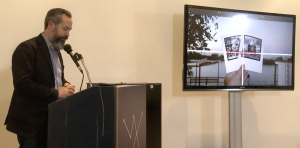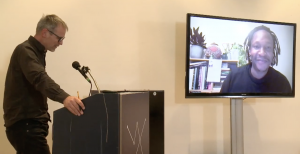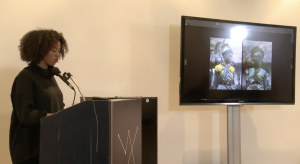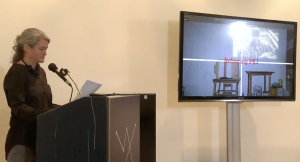May 27th 2021 this website was launched during the symposium ‘Undisciplining Photography‘, organised by the MA Photography & Society of the Royal Academy of Art with the Nederlands Fotomuseum in Rotterdam, and the Research Centre for Material Culture in Leiden. A full recording of the live broadcast of the launch can be found here.
The launch was moderated by Bridging Humanities editor Laurens Nijzink, who also positioned the publication within the context of the platform (from 9:40). Martijn van den Broek, head of collections at the Nederlands Fotomuseum introduced the PJU collection (from 1:50). Dr. George Mahashe shared some first thoughts in relation to this publication (from 38:20), which will be further elaborated upon in a peer review that is published once available.
Writer and researcher Esther Aminata Kamara read a fictional story written (from 24:00) in respons to photographs produced in Sierra Leone in 1934 after thoughtfully positioning herself as well as Paul Julien as writers. Below is the full text of Esther’s contribution. Another iteration of the story is part of a film made for an exhibition in the 2021 Noorderlicht Photo Festival titled “The Makeable Mind”. That film, titled “Real Time” can be seen here. Under Esther’s contribution to the website you will find the goodbye letter to Dr. Julien I read during the website launch (from 13:30).
Introduction
The story I will share with you today has us witnessing the arrival of Paul Julien in a village in Sierra Leone. His arrival is seen from the eyes of Natu- a fictional character I dreamt up after months of interacting with Julien’s work.
In this story, the acts of seeing, witnessing, exposing, and capturing affect how the story develops. It’s… perhaps very enticing to reclaim some form of agency by changing perspectives, by turning the seen into the seer. But my reasons for doing so is not to expose some perversion of voyeurism. No, I use this format to reveal the fictionality of my narration.
And with that, try to expose this fictionality in Julien’s work.
As a writer I use sense data, combine it with introspection and a good dose of magic to create a story. In this case, I used data from Julien’s works, my own experiences of being in Sierra Leone/ a Sierra Leonean, and the knowledge I’ve gained through my upbringing as the building blocks of this story. What I want to expose is my understanding of authorship. The various- as I call them- corrupting influences that, no matter how objective I try to be, always soil my work.
This. Is what I see as my corrupting influences.
Layer one: macro-contexts
The layer of growing up in postcoloniality. Of living in the information age. Where one can travel to other continent with mere clicks and keyboard tabs.
Layer two: macro-micro contexts
Of being a second-generation Dutch woman with an African migration background, of being an Amsterdam youth, a woman of colour, of consuming thousands of books. This the layer of my educational background.
Layer three: micro contexts
Of being a writer, a researcher, my millions of thoughts and interactions. Of being tired to always be so binary: of being victim, or being perpetrator. Now, I believe that the same can be said for Paul Julien, that his influences corrupted his work as well. Therefore, I identify the following corrupting influences of Paul Julien.
Layer one: of time
Of living during an era of missionary works, of western scientific rationality, of blood-research and skull measurements, of a past world war and another war to come.
Layer two: of spirit
Of colonialism, of hand-drawn maps, of going where no ‘man’ has gone before, of illuminating the dark continent, of each step taken counting as one step forwards.
And finally:
The layer of being a man, his family past, his beliefs and convictions, his experiences, and thoughts, all forming the mind and hand which guide his pen and camera, his footsteps. And when he walks, fuelled by admiration, and curiosity, and righteousness, he creates a new narrative – a narrative that we still have access to today.
As authors, such corrupting influences affect how we create. But by exposing this process I hope to reveal some of the workings of power and the narrative. And allow us to be critical towards the teller, and the told. Who am I to tell the story of the Bundu girl in the picture? Who am I to name the nameless? Who do I want the people in Julien’s works to be?
All I can give you- ever, is fiction.
Story 1: Exposure
Part I- Looking/ Seeing
It was as if the crickets announced his arrival. As if his inner spirits called upon them to make his anthem. To let us villagers know that his world was made of the same materials as ours, so that he could inhabit it.
I knew his convoy was snaking through the bush. My brother had seen them coming from afar when he went to wash in the boy’s stream. He ran- this boy was always running- as fast as his spindly legs could take him. His eyes wide with feverish excitement, chest heaving as he drew breath.
“I saw him.”
My hard face betrayed no shared anticipation.
“Natu,” he shook my shoulder, “I saw him. This man must be a devil chief. Natu!”I pushed his hand off my shoulder and sucked my teeth.
“Lef me Sorie, I am thinking.” But even this could not dull the shimmer in his being.
“Who cares about thinking, you need to see Natu, what they say is a lie, he is not white at all! He is without skin.”
He took a dramatic pause to let that sink in, and for a second, I did envision a skinless devil. How his blood pumped through his exposed arteries, his gums slimy and moist like that of a snail. But then I straightened my back and averted my gaze.
“Sorie, I don’t have time for your stupid lies. And look at how dirty you are – you just washed! Now lef me.”
Sorie was always up to no good. Although he was only three rains my junior, it was as if his spirit wanted to remain playful forever. Sorie knew all the hiding spots, the mataodo I so dreaded using behind which he could hide and listen in on the elder’s conversation. The long branch of the mango tree where he could watch the wives quarrel, and the bush where the snake spirit dwelled, not far from the cooking huts, where he could sneak into the pots and steal goat meat without being seen. When he was caught the aunties would beat him with sticks, but never with full intensity, and after these beatings he was almost immediately ready for his next stupidity.
I used to love his tricks, but lately his presence stung like a mosquito I couldn’t swat. Like his energy just made me angry. His tirelessness made me tired. His gossiping (sometimes real kongosa, sometimes boy fantasies) was childish- I had to stand above it. If I ever wanted to become a respected Sampa Baromé I would have to leave such stupidities behind. So, when he came running to me telling me about this skinless devil chief, I envisioned myself as the most impressive dancer this village had ever produced. My legs shaking awake the spirits that lay dormant in the soil and rivers, eyes filled with admiration as I never stopped to catch my breath. It could be any moment now that they collected us for the Sandé, and that I would become a real woman, and no one would steal my chance of becoming the next Sampa Baromé. The other girls all envied my body, whispering that I somehow cheated because I already knew so many steps. Jealous kongosa.
Part II- Seeing/ taking
“You should stand to greet,” said my older brother as he slowly approached me. Ever since he became an initiate, he wouldn’t look at me straight. Even now, he acted as if the mud’s walls I was leaning against were more interesting than my face. But I knew what his slanted gaze meant. Don’t hide in plain sight, it’s disgraceful. Then he turned away, paused for another second, and walked towards the crowd that had gathered near the meeting square. I closed my eyes, let the sound of the crickets envelop my being, tuned in to the cooling dusk air, trying to block out the excited buzzing of the villagers. When I opened my eyes, I saw my older brother looking back at me, directly this time.
**Suckteeth**
I sucked my teeth and dragged my feet. What a pain.
When the first carriers in the convoy arrived something immediately changed. The villagers were whispering. Confusion. Is he a chief, or a king? No, he is a doc-tor. Do doc-tors move like chiefs? No, he is a white doc-tor. Oooh, ok
People straightened their spine, eyes cast downwards respectfully. Sideway glances trying to absorb everything about the approaching visitor.
I couldn’t see a thing, the backs of older men and women obscuring my view. Sorie, the annoying bug, stood next to me, desperately trying to get a good look.
“Natu,” he whined.
“I can’t see! Lift me up.”
“Sorie, no! What are you thinking!” I hissed.
And then Sorie was gone. I tried to look for him without being obvious and spotted him behind the mataodo. The white of his eyes flickered in the darkening light. Then, a shudder in the crowd. Nobody was looking downwards anymore, they all stared ahead. And I moved sideways, trying to catch a glimpse- and it was as if all other things became invisible. Like how the moon can sometimes erase the stars.
His face was aimed right at me. Not skinless, no- like the skin that shows when you fall and scape, naked skin. Like maggots squirming in decomposing flesh. A beautiful destructive force.
— then his eyes grabbed mine. They held me there. Locked, soil gripping, muscles not obeying – his eyes went inside of me, hunter eyes, plotting eyes, eyes that turned my legs into charcoal, unsteady, failing.
Then he smiled, and his mouth broke the spell of his eyes.
Finally my legs obeyed,
I ran.
—
Part III- Exposing/Capturing
There was something wrong with this man. I did not believe that he was a devil, nor that he was a king. Still, every time I let my mind wonder; my mind fell into these eyes of his. As if his eyes were mouths and he was eating me.
I sat crouched behind our hut, staring at my feet- my dancer’s feet, flat and strong. Nimble.
In the dying light I could only see colours in shades. Dark, darker, darkest. The smell of cooling earth mingled with that of roasting meat. The usual village sounds stronger now that this man had come. The pounding of pepper louder, the friendly chatter friendlier, the movements hurried.
Then, a shuffle nearby, a whisper:
“Natu,”
Sorie really knew all my hiding spots. The annoying bug.
“Sorie, go away!”
“I saw you run.”
I ignored him. Stared at the bush. Darkest.
“They were talking about you.” His voice had the tantalising sweetness of honey. Ready to trap greedy minds.
Now I looked at him. His teeth lighting up in the dark as he grinned his annoying bug-smile.
He continued in his kongosa voice.
“You know how I speak Krio far better than you. Look, this whiteman does not like our food. That is why he brought his own cook. Imagine! Our roast meat is the best – “
“Sorieee -I don’t care! Tell me now, did they really talk about me?”
He shifted.
“Well, so first I thought this man must have a devil voice, but it is high like a young girl. And his Krio is bad bad one, even I can tell- “
I nudged him with my elbow.
“Ok ok ok, he asked if you were a Bundu girl. Then the chief said, “Yes she is, and she is promising.”
Despite my doubt of my brother’s honesty, I couldn’t help but feel pride swell my chest.
“Are you sure? How did you know it was me? It could have been another girl.”
“Look at your hair, nobody wears their hair with your weird style,” he laughed. “He said something like palmtri. Palmtri!”
I pinched his earlobe. He cried out in pain. I wanted him gone but he was enticing me with his stories.
So, I urged him on.
“Why? What does he want?”
Sorie clicked his tongue. “I will only tell you if you admit that I am the best hunter of information. I am the chief of kongosa, the master of knowle-“
“Au! Ok ok ok please release my ear.”
“He has a machine; it is like a juju machine. He uses it to take pikcho. This pikcho takes your spirit and places it in a paper. He wants to take it with him.”
I searched his eyes for lies, but all I could see was the last light of the day fading away in his sockets. Then I looked away. An unknown feeling was slowly creeping over my back, like a snake spreading his venom, and for once, I did not know how to move.
My voice was small, “But I thought he was a doctor. Is this like a doctor machine?”
“Yes, this pichko takes your spirit so that it can travel. And then when it has you, you will never find rest. That is what they said. It’s true! Because the white man does not believe in our Poroh society. That way he will doctor you.”
Silence descended. The background noise of crickets filled my head entirely. Deafening, as if they wanted me to bury my thoughts.
“Sorie.” I whispered. “What should I do?”
It was so dark now that I could not see his face, but I knew that he was gloating.
“Well… if you don’t expose it, nobody can take it. If you don’t show it, nobody can see.”
At first, I did not understand what this trickster meant. But then I gasped with understanding. I pinched his ear, “au, Natu!?” and sucked my teeth. And in my mind, I saw a plan unfolding.
— End of story 1 —
“Almost everything […] is invented. But it’s not a game. It’s a form.”
Tim O’Brien in The Things They Carried, p.171
“Let me not just tell you all of this but rather allow you to see it for yourself.”
Paul Julien in a radio lecture broadcasted January 26th 1941
May 27th 2020
Dear Dr. Julien,
I am happy to inform you that I have finally found an appropriate and comprehensive mode of presentation, a Good Form so to speak, in which to present the activation of your legacy. Before I introduce you to it, there are two nagging questions that kept popping up as I developed this form. What did Good Form mean to you? And by extension which Truth did you present to your Dutch audiences?
As I see it, Tim O’Brien’s use of the words “Good Form” and “Truth” in his novel ‘The Things They Carried’ (1990) are important. O’Brien (1946) is an American novelist and army veteran who, in this book, writes about some of his experiences as a soldier in the Vietnam War. There are fewer narratives in the book than there are chapters. That is, the same narrative is told several times through different perspectives that overlap and to some extent contradict each other. In the shortest chapter of the book, O’Brien suggests, and I paraphrase him here, ‘that Good Form is about making things present. About looking at things one never looked at. About being able to be brave and about being able to feel, or feel again,’ rather than about being true to what was experienced. He speaks in this regard about two types of truth, Happening Truth and Story Truth. The former being what was experienced by those who took part in an event, the latter what is presented to- and experienced by those encountering a narrative.
I assume you would agree with Timothy O’Brien that these truths exist and are important to distinguish. In your case, for instance, there is a truth in which you spent barely more than three weeks in Sierra Leone and another one in which you were stuck in a rainy camp for two months before embarking on the challenging climb up Mount Kunon.
The first truth is the one I deducted from your notebook and the letters written to your parents. The second truth is the one told by you in the first chapter of your book ‘Campfires Along the Equator’.
This book is still widely available in second hand book stores in the Netherlands, as I’m sure you can imagine due to the sheer number of editions produced. It cements the Story Truth of ‘an African life’, posited throughout the 1930s in your radio lectures. With increasing amazement I have noted how you maintained this claim over the six decades of your life that followed the initial publication of the book in 1940, including almost forty years in which you no longer set foot on the African continent.
While working with historical photographs in Uganda between 2008 and 2012 I developed an understanding of the limitations of my western-informed reading of pictures.[1] This resulted in the platform History in Progress Uganda and eventually in the PhD dissertation Ebifananyi, a study of photographs in Uganda in and through an artistic practice Where I, for instance, only saw colonial propaganda, it was pointed out to me that the meaning and value of such photographs was not limited to the intention with which they were made. These pictures also included clues about life in Uganda beyond the interest of the colonial context. These clues could only be made meaningful by Ugandan elders. They should be facilitated to share their observations with a younger generation in order to help them make sense of their – our – present. Building on such experiences, I consider your photographs to be capable of initiating wider conversations that could in turn provide alternatives for your framing of the African past and thus contribute to a multi-directional mode of remembrance.
This brings me back to the Good Form I developed, as it aims to contribute to a remembrance that does not take your positioning of the past, presented in the photographs you produced, at face value. This Good Form aims to be critical and inclusive. Critical of the colonial conditions in which you operated; of the privileges; the more and less overt racism present in your language and tangible in a substantial part of the photographs you produced. Inclusive in terms of audience, where your audience was exclusively European, the one I aim to reach out to includes people on and from the African continent. In fact, in the context of the Good Form that I developed, I do not think of them as members of an audience but as visitors to a virtual space. A virtual space constructed through an open ended stream of encounters from which I hope they all benefit. The idea is that the space itself is open to, and will develop further through, responses by visitors.
With this Good Form, I intervene in the state in which the pictures you produced used to be available, illustrating your texts in books and printed media and appearing alongside your stories in television shows. The interventions manifest in simple animations that I think of as Breathing Photographs in which pictures that have a significant formal overlap blend into one another in a tempo that is close to the lower average respiration rate of human breathing.
Five seconds in, five seconds out.
In the Breathing Photographs, the scenes that were photographed by you are present but never fixed. The singularity of the individual photographic frame is literally expanded in space and through time. As such, the Breathing Photographs resist the normality that existed with your publications in which it was a matter of course that ‘we’ in Europe could look at ‘them’ in Africa.
Making these Breathing Photographs expands my understanding of the events, as well as the intensity with which you photographed. An example of this is the Breathing Photograph that consists of twenty four exposures made on August 8th or 9th 1934 in Dambarra. You may recall Paramount Chief Moriba Kargobai organising performances of masks, dancers and musicians for you. Combining the twenty four individual frames also reconstructs a panoramic view of the village.
I am no longer limited to the materiality of photographs for their presence. Instead I can source photographs, reproduce them, share them individually and make them publicly available through a digital, electronic network. Through this network the Breathing Photographs appear on demand on screens owned, perhaps not by everyone, but by many, including Moriba Kargobai’s son Desmond Kargobai, who is the current Paramount Chief of Selenga Chiefdom, including Dambarra village.
This same network makes it possible for me to bring pictures together from different origins, produced by your predecessors, contemporaries or me. They still overlap formally as well as in content with photographs from your legacy. The resultant Breathing Photographs provide insights into historical conventions and make it possible to compare your past to our present.
The Breathing Photographs are presented in a radically networked way. The brief texts that accompany them include connections that can be electronically activated and lead to other related Breathing Photographs. Through these connections, members of the audience are invited to find their own route through your legacy, reframed in Breathing Photographs. This Good Form does not present a linear narrative. Instead stories are given a chance to unfold in the engagement of visitors.
The Breathing Photographs allow me and visitors of the virtual space to reconstruct, to speculate and to develop open ended dialogical yet critical formations of imagination. They are both a research method and a provisional outcome of my research. They allow me to centralise the photographic encounter and its visual output or origin while investigating your legacy and to decentralise spoken and written text. This contrasts quite sharply with the data you collected and the facts, figures and ethnographic observations in which you presented your research.
In the letters I wrote with you as an addressee over the past two years you have a central position. These letters were a Good Form in the sense that they forced me to be inclusive of you and the conventions that informed your actions. They generated, you could say, a Happening Truth. Thanks to this form I could not simply distance myself from your position that I, as elaborated on in previous letters, found and find so deeply troubling. Now that I have this Good Form at my disposal I can say goodbye to you and fully focus on what I can learn from working with the photographs you so skilfully produced. For which, myself and seemingly many of the people who have contributed to the activation of your legacy with me, remain grateful,
With best regards,
Andrea
References
| ↑1 | This resulted in the platform History in Progress Uganda and eventually in the PhD dissertation Ebifananyi, a study of photographs in Uganda in and through an artistic practice |
|---|





